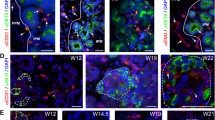Summary
Segments of rat thoracic duct cultured in plasma clot or in collagen gel produced microvascular and fibroblastic outgrowths. Lymphaticlike channels (LLC) with a highly attenuated endothelium, which was barely visible by light microscopy, were found in 8 out of 25 cultures (32%). Serial histologic sections revealed that the endothelium of the LLC was continuous with the intimal endothelium of the throacic duct and was therefore of lymphatic origin. In addition to the LLC, vascular channels lined by a thick endothelium with hump-shaped, cross-sectional profiles were found in 10 cultures (40%). These channels were indistinguishable from the microvessels of blood vascular origin that formed in parallel cultures of rat aorta or periductal adipose tissue and were termed hematiclike channels (HLC). Contrary to the LLC, the HLC did not originate from the lymphatic endothelium of the thoracic duct. The frequent association of the HLC with the adventitia of the thoracic duct and with the surrounding adipose tissue suggested that they probably developed from the hematic microvessels of the periductal soft tissues.
Similar content being viewed by others
References
Casley-Smith, J. R. Lymph and lymphatics. In: Kaley, G.; Altura, B. M., eds. Microcirculation, vol. 1. Baltimore, MD: University Park Press; 1977: 423–502.
Clark, E. R.; Clark, E. L. Observations on the new growth of lymphatic vessels as seen in transparent chambers introduced into the rabbit’s ear. Am. J. Anat. 51(1):43–87; 1932.
Huntington, G. S. The development of the mammalian jugular lymph sac, of the tributary primitive ulnar lymphatic, and of the thoracic duct. Am. J. Anat. 16:259–316; 1914.
Jaffe, E. A. Physiologic functions of normal endothelial cells. In: Lee, K. T., ed. Atherosclerosis. Ann. NY Acad. Sci, vol. 454. New York: New York Academy of Science; 1985; 279–291.
Johnston, M. G.; Walker, M. A. Lymphatic endothelial and smooth muscle cells in tissue culture. In Vitro 20(7):566–572; 1984.
Leak, L. V. Electron microscopic observations on lymphatic capillaries and the structural components of the connective tissue-lymph interface. Microvasc. Res. 2:361–391; 1970.
Leak, L. V.; Burke, J. F. Ultrastructural studies on the lymphatic anchoring filaments. J. Cell Biol. 36:129–149; 1968.
Leak, L. V.; Burke, J. F. Early events of tissue injury and the role of the lymphatic system in early inflammation. In: Zweifach, B. W.; Grant, L.; McCloskey, R. T., eds. The inflammatory process, vol. 3. New York: Academic Press; 1974: 163–236.
Maciag, T. Angiogenesis. Prog. Hemost. Thromb. 7:167–182; 1984.
Montesano, R.; Orci, L.; Vassalli, P. In Vitro rapid organization of endothelial cells into capillary-like networks is promoted by collagen matrices. J. Cell Biol. 97:1648–1652; 1983.
Nicosia, R. F.; Tchao, R.; Leighton, J. Histotypic angiogenesis in vitro: light microscopic, ultrastructural, and radioautographic studies. In Vitro 18:538–549; 1982.
Reynolds, E. S. The use of lead citrate at high pH as an electronopaque stain in electron microscopy. J. Cell Biol. 17:208–212; 1963.
Sabin, F. R. On the origin and development of the lymphatic system from the veins and the development of the lymph hearts and the thoracic duct in the pig. Am. J. Anat. 1:367–389; 1902.
Sandison, J. C. Observation on growth of blood vessels as seen in transparent chamber introduced into rabbits’s ear. Am. J. Anat. 41:475–496; 1928.
Schoefl, G. I. Studies on inflammation III. Growing capillaries: their structure and permeability. Virchows Arch. [A] 337:97–141; 1963.
Willis, R. A. Metastasis via lymphatics and the cancerous thoracic duct. The spread of tumours in the human body. St. Louis: C. V. Mosby Co.; 1952: 18–35.
Author information
Authors and Affiliations
Additional information
This research was supported by grants from the National Cancer Institute, NIH, National Bladder Cancer Project (CA14137), and the W. W. Smith Charitable Trust.
Rights and permissions
About this article
Cite this article
Nicosia, R.F. Angiogenesis and the formation of lymphaticlike channels in cultures of thoracic duct. In Vitro Cell Dev Biol 23, 167–174 (1987). https://doi.org/10.1007/BF02623576
Received:
Accepted:
Issue Date:
DOI: https://doi.org/10.1007/BF02623576




